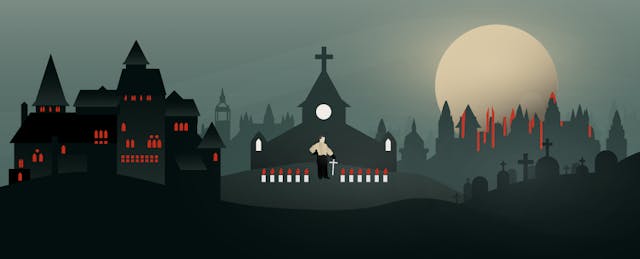When Stanley Stepanic was growing up in Latrobe, Pennsylvania, he lived in a house built in 1823. “Back then,” he says, “it was always cool to say, ‘I live in a haunted house. There’s a ghost here, and she committed suicide during the Civil War.’”
“I was obsessed with ghosts and skeletons,” he says, “and Halloween was always my favorite holiday.”
When he was five or six years old, Stepanic told his mother he wanted a Halloween-themed birthday party. “I had a cake with a skeleton,” he says, “and I dressed as Dracula.”
It was destiny.
Decades later, Stepanic teaches a standing-room-only class at the University of Virginia entitled—cue up the spooky organ music—Dracula. The course is one of the school’s most popular, with a waitlist that once swelled to 1600; it was included in a roundup of “Top 10 Must Take Classes at UVA.”
An associate professor in UVA’s Department of Slavic Languages and Literatures, Stepanic earned the Graduate School of Arts and Sciences Teacher of the Year Award in 2012. He has also been selected as a Master Educator by the education technology company Course Hero, which produced a ten-minute film that features Stepanic and his crowd-pleasing class.
With Halloween upon us, we chatted with Stepanic about what his course addresses, how it became so popular, and why Bram Stoker’s Dracula is not a required read.
EdSurge: Can you give us a little background on the history of the Dracula course?
Stanley Stepanic: When I first came to UVA in 2005 to study for my master’s and my PhD, I was a teaching assistant to the course and was mentored by Professor Jan Perkowski. He had originally taught the class under the title of Vampires of the Slavs. He later changed the name of the course to Dracula. When I came here in 2005, the course had been taught for at least two decades.
When Perkowski retired, the department wanted to keep the course because it was their biggest in terms of enrollment. Since I was the last person who had taught it and knew anything about the subject at all, they asked if I wanted to do the course myself.
So I said, “Sure, but I’m going to do it entirely different. I am going to rework the course from the ground up. It’s going to be nothing like how it originally was, other than that title. I’ll keep the title.”
What do you cover in your course?
The title, Dracula, is actually just symbolic. Basically, I track the development of human experience and human history, using the vampire as the frame to make it fun. We talk about anthropology. We talk about diseases, issues of racial identity, homosexuality—things you wouldn’t expect. Students usually are amazed when they take it.
We talk about the prehistory, the Slavs, Eastern Europe, then we go all the way to the modern day. Then we see what is a vampire, in the original folklore what does it mean, and then from there we see how that thing was adapted and assimilated and appropriated by Western culture and gets into literature. And then we go from literature to theater and then films and then pop culture in general.
The big takeaway is that the vampire is an expression of the human species itself. It has over time become a mirror for what we are, or for things we strive to be and haven’t achieved.
How do you teach a class called Dracula and not require students to read Stoker?
I used to have Dracula as one of the core texts. But students didn’t like it; they hated the book. Typical complaints are that it’s too confusing at some points; there are plot holes in it; and the characters are fake, I can’t connect with them. I don’t like the book personally. So I just took it out.
It’s really interesting to me that most people actually have not read the book. But they know that name and they think it’s the most famous work in horror literature ever written.
How do you keep your students engaged?
This is one of the big changes I implemented. If you’re not entertaining students enough, they’re not going to pay attention to you. Professors will often ask me, “Why are you so good? What do you do that’s different?” I always say the same thing: You have to envision yourself as basically an entertainer.
Even though you’re teaching them, you have to entertain them at the same time. Otherwise 1) they’re not going to pay attention, and 2) they’re not going to learn. If you entertain them while they learn, they’re going to learn a lot more. I’ve always loved public speaking, so that was easy. But I realized early on, students are more and more visually oriented. So, if I’m talking about a film, I’ll show some of the original film posters or perhaps a clip or a trailer. It gives you a visual perspective of that time period.
How do you leverage technology in your course?
I’ve automated the grading for my essay test, which I was finally able to do with the help of a friend who programmed me a special little system this past year that I call Alucarda. [Editor’s note: What is alucarda spelled backward?] That’s made grading a lot faster and easier. I can do 30 exams in 15 minutes, which used to take me three days.
There’s one other thing I should mention about why the class has become so popular. I’ve always tried to keep up-to-date with the way the technology is advancing. So now I’ll use Google maps, archive.org, YouTube, the Internet and other sources students use.
How do you pump new blood into your course?
Every semester I’m like, “I don’t like this slide. I need a clearer picture of this. I don’t like the way the text appears.” Every once in awhile, I’ll come across something new like a video. “Ooh, I could use this for this lecture.” I download them to save for later. So there are always things that I’m changing. Every semester it’s going to be a different course. The other thing we’ve got going is, of course, the vampire’s not going anywhere. It’s going to be in the media probably until the human race is extinct. Because the vampire represents problems we have yet to solve, and until we solve those problems, it will be one of the methods we use to symbolize them in order to cope with our lack of understanding.
As a friend of mine once said, as a professor these days, you just can’t keep teaching the same notes with coffee stains from the 1950s on them. You’ve got to be updating. You’ve got to be looking at what students are doing. So who knows how lectures will be taught 20 years from now. Whatever it is, I’ll be teaching that way. Maybe we’ll have some new social media app and we’ll be plugged into computers in our brains and you can experience Dracula through your eyeballs.
Whatever is going to happen, I’m going to have to adapt to it. You have to make yourself as relevant as possible every single year.
The Good Words
Here are six of Professor Stepanic’s go-to books for research on vampires:
1. The New Annotated Dracula, by Bram Stoker and Leslie S. Klinger
2. Bram Stoker: A Biography of the Author of Dracula, by Barbara Belford
3. Vampires, Burial, and Death: Folklore and Reality, by Paul Barber
4. The Vampire Film: From Nosferatu to True Blood (Fourth Edition), by Alain Silver and James Ursini
5. Bram Stoker's Notes for Dracula, by Robert Eighteen-Bisang and Elizabeth Miller
6. Dracula (Norton Critical Edition), by Bram Stoker, edited by Nina Auerbach
Vamping for the Camera
The vampire has been a cinematic stock-in-trade since the French short "Le Manoir Du Diable" was released in 1896, a year before Stoker’s Dracula was published. Here are five vampire films and one anime series recommended by Professor Stepanic:
1. "Hellsing Ultimate" (2006–2008, 2012, 2014; created by Kohta Hirano)
2. "Blade" (1998; directed by Stephen Norrington)
3. "Bram Stoker's Dracula" (1992; directed by Francis Ford Coppola)
4. "Dead of Night" [aka, Deathdream] (1974; directed by Bob Clark)
5. "Dracula’s Daughter" (1936; directed by Lambert Hillyer)
6. "Interview with the Vampire: The Vampire Chronicles" (1994; directed by Neil Jordan)



